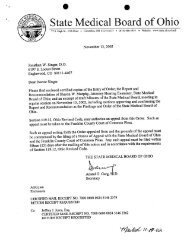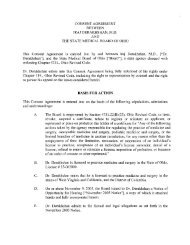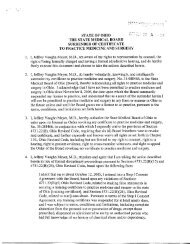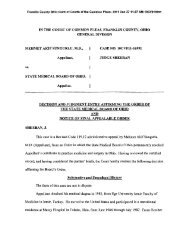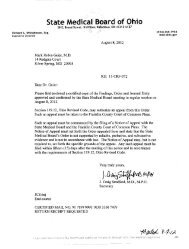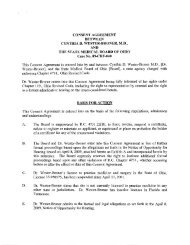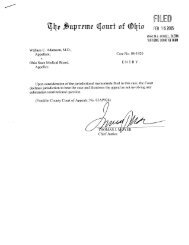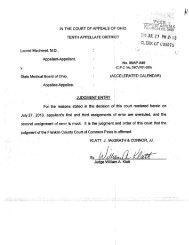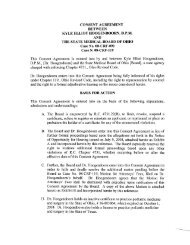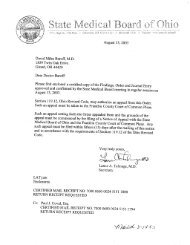l' 66 8' t A 9 5' - State Medical Board of Ohio
l' 66 8' t A 9 5' - State Medical Board of Ohio
l' 66 8' t A 9 5' - State Medical Board of Ohio
Create successful ePaper yourself
Turn your PDF publications into a flip-book with our unique Google optimized e-Paper software.
Report and Recommendation<br />
In the Matter <strong>of</strong> Robert Alan Graor, M.D.<br />
Page 2<br />
B. Presented by the Respondent<br />
1. Roy Chu, Ph.D.<br />
2. James Gentry Laws, D.O.<br />
3. Leslie Graor<br />
4. Robert Alan Graor, M.D.<br />
5. Gordon John Garrett<br />
6. Troy Alan Tyner<br />
II. Exhibits Examined<br />
A. Presented by the <strong>State</strong><br />
1. <strong>State</strong>’s Exhibits 1A-1S: Procedural exhibits.<br />
2. <strong>State</strong>’s Exhibit 2: Certified copies <strong>of</strong> documents regarding Dr. Graor maintained<br />
by the <strong>Board</strong>. (Note: pages numbered by the Attorney Hearing Examiner posthearing).<br />
3. <strong>State</strong>’s Exhibit 3: Certified copies <strong>of</strong> documents regarding Dr. Graor maintained<br />
by the Cleveland Clinic Foundation. (Note: pages numbered by the Attorney<br />
Hearing Examiner post-hearing).<br />
4. <strong>State</strong>’s Exhibits 4 and 5: Undated curriculum vitae for Dr. Graor.<br />
5. <strong>State</strong>’s Exhibit 6: Copy <strong>of</strong> an application for liability insurance for Dr. Graor.<br />
6. <strong>State</strong>’s Exhibit 7: Copy <strong>of</strong> documents related to Dr. Graor’s application for<br />
privileges at Good Samaritan Hospital in Dayton, <strong>Ohio</strong>. (Note: pages numbered<br />
by the Attorney Hearing Examiner post-hearing).<br />
7. <strong>State</strong>’s Exhibit 8: Certified copies <strong>of</strong> documents related to Dr. Graor’s<br />
application for faculty appointment at Wright <strong>State</strong> University School <strong>of</strong><br />
Medicine in Dayton, <strong>Ohio</strong>.<br />
8. <strong>State</strong>’s Exhibits 9 and 10: Copies <strong>of</strong> letters to the <strong>Board</strong> from Elizabeth A.<br />
Hopkins, Associate Vice President, Registration and Credentials, ABIM.<br />
9. <strong>State</strong>’s Exhibit 11: Copy <strong>of</strong> a letter to the <strong>Board</strong> from Andrew S. Hannah,<br />
Acting University Registrar for Pritzker School <strong>of</strong> Medicine <strong>of</strong> the University <strong>of</strong><br />
Chicago.
Report and Recommendation<br />
In the Matter <strong>of</strong> Robert Alan Graor, M.D.<br />
Page 3<br />
<strong>State</strong>’s Exhibit 12: Copies <strong>of</strong> documents regarding Dr. Graor’s original<br />
application for licensure in <strong>Ohio</strong> as maintained by the <strong>Board</strong>.<br />
B. Presented by the Respondent<br />
1. Respondent’s Exhibit A: Dr. Graor’s Application for Appointment to the<br />
<strong>Medical</strong> Staff at Franciscan <strong>Medical</strong> Center, Dayton, <strong>Ohio</strong>.<br />
2. Respondent’s Exhibit B: Dr. Graor’s Application for Appointment to the<br />
<strong>Medical</strong> Staff at Miami Valley Hospital, Dayton, <strong>Ohio</strong>.<br />
3. Respondent’s Exhibit C: Copy <strong>of</strong> a February 7, 2000, electronic mail message<br />
from Elizabeth A. Hopkins to Internet: OHCardiac@aol.com.<br />
Note: Social security numbers were redacted from exhibits by the Attorney Hearing<br />
Examiner with the agreement <strong>of</strong> the parties. See Hearing Transcript at 215.<br />
SUMMARY OF THE EVIDENCE<br />
All exhibits and transcripts <strong>of</strong> testimony, even if not specifically mentioned, were thoroughly<br />
reviewed and considered by the Attorney Hearing Examiner prior to preparing this Report and<br />
Recommendation.<br />
1. Robert Alan Graor, M.D., received his degree in medicine in 1978 from the University <strong>of</strong><br />
Health Sciences – The Chicago <strong>Medical</strong> School in Chicago, Illinois. Subsequently,<br />
Dr. Graor completed a residency in internal medicine and a fellowship in peripheral<br />
vascular disease at the Cleveland Clinic Foundation [Cleveland Clinic] in Cleveland, <strong>Ohio</strong>.<br />
(Hearing Transcript [Tr.] at 151-152; Respondent’s Exhibit [Resp. Ex.] A).<br />
Dr. Graor testified that, six years later, he participated in a cardiovascular disease<br />
fellowship. He stated that the cardiovascular disease fellowship was “a modified<br />
fellowship that was equivalent to the standard fellowship” <strong>of</strong>fered by the Cleveland Clinic.<br />
He explained that it had been modified because he was then employed at the Cleveland<br />
Clinic and, to do a standard fellowship, he would have had to terminate his employment.<br />
Therefore, his chairman had allowed him to complete the fellowship while he continued<br />
his employment. Dr. Graor testified that he had not received a certificate documenting his<br />
completion <strong>of</strong> the fellowship. Instead, one <strong>of</strong> the physicians provided him with a letter<br />
stating that he had completed an equivalent fellowship. (Tr. at 153-155).<br />
Dr. Graor has never been certified by the American <strong>Board</strong> <strong>of</strong> Internal Medicine [ABIM].<br />
Moreover, Dr. Graor has never been eligible for certification in cardiology. (Tr. at 136-<br />
137; <strong>State</strong>’s Exhibit [St. Ex.] 9; Resp. Ex. C). Dr. Graor testified that he had taken the
Report and Recommendation<br />
In the Matter <strong>of</strong> Robert Alan Graor, M.D.<br />
Page 4<br />
examination for certification in internal medicine in 1981 but failed the examination. He<br />
did not attempt the examination a second time. (Tr. at 249; Resp. Ex. C).<br />
2. In August 1979, Dr. Graor signed an application for licensure in <strong>Ohio</strong>. With the<br />
application, Dr. Graor submitted a copy <strong>of</strong> his diploma from the University <strong>of</strong> Health<br />
Sciences - The Chicago <strong>Medical</strong> School. The <strong>Board</strong> issued Dr. Graor a license in<br />
September 1979. (St. Ex. 12).<br />
3. Dr. Graor was employed by the Cleveland Clinic from January 1982 through<br />
September 1994. Initially, Dr. Graor served as a staff physician in internal medicine and<br />
peripheral vascular disease. Subsequently, he served as a staff physician in cardiology.<br />
(Tr. at 161, 260).<br />
4. Documents maintained by the Cleveland Clinic include a curriculum vitae for Dr. Graor<br />
submitted to the Cleveland Clinic in September 1981. (St. Ex. 2). Dr. Graor testified that<br />
he had not submitted a curriculum vitae to the Cleveland Clinic. Dr. Graor explained that<br />
he had been a student prior to that time and he had not yet created a curriculum vitae.<br />
Dr. Graor testified that his first curriculum vitae was “developed” or “generated” by the<br />
Cleveland Clinic. He stated that the secretaries in his department had created curricula<br />
vitae for the staff physicians. (Tr. at 162, 164, 175).<br />
Nevertheless, in later testimony, Dr. Graor stated that he did not know whether he had<br />
prepared the curriculum vitae himself or if it had been prepared by someone else.<br />
(Tr. at 250-251; St. Ex. 3 at 3).<br />
5. In a Staff Biography attached to the 1981 curriculum vitae, Dr. Graor indicated that he had<br />
been board certified in internal medicine in 1981. Nevertheless, in handwriting other than<br />
Dr. Graor’s, there is a notation which states “failed exam 1981.” Dr. Graor testified that he<br />
assumed that a record keeper at the Cleveland Clinic had added the notation that he had<br />
failed the examination in 1981. (Tr. at 249; St. Ex. 3 at 2).<br />
Dr. Graor admitted that he had indicated in the Staff Biography that he had been certified<br />
in internal medicine in 1981. Dr. Graor explained that he had completed the Staff<br />
Biography after taking the certification examination but before receiving the results. He<br />
further explained that he had claimed to be board certified because he had anticipated that<br />
he would do better than he had. (Tr. at 167-169, 247-249; St. Ex. 3 at 2).<br />
6. At some time during Dr. Graor’s employment with the Cleveland Clinic, Dr. Graor<br />
completed an Application for Membership and Classification Blank for the Academy <strong>of</strong><br />
Medicine <strong>of</strong> Cleveland. In that document, Dr. Graor indicated that he had received a<br />
medical degree from the “University Chicago <strong>Medical</strong> School.” (St. Ex. 3 at 5; Tr. at 252).
Report and Recommendation<br />
In the Matter <strong>of</strong> Robert Alan Graor, M.D.<br />
Page 5<br />
Dr. Graor testified that the University <strong>of</strong> Health Sciences – The Chicago <strong>Medical</strong> School<br />
now known as the Finch University <strong>of</strong> Health Sciences – The Chicago <strong>Medical</strong> School, is a<br />
separate and distinct institution from the University <strong>of</strong> Chicago, Pritzker School <strong>of</strong><br />
Medicine. (Tr. at 152, 156, 243).<br />
Dr. Graor admitted that he “may have” used the term “University <strong>of</strong> Chicago <strong>Medical</strong><br />
School” when discussing his medical education. Dr. Graor acknowledged that that was not<br />
the name <strong>of</strong> the institution from which he had obtained his medical degree, but stated that<br />
people who went to the University <strong>of</strong> Health Sciences – The Chicago <strong>Medical</strong> School <strong>of</strong>ten<br />
referred to it as the “University <strong>of</strong> Chicago <strong>Medical</strong> School.” (Tr. at 155-156).<br />
Dr. Graor later testified that, if he had stated in a curriculum vitae or in an application that<br />
he had attended the University <strong>of</strong> Chicago <strong>Medical</strong> School, it had been a correct statement.<br />
Moreover, Dr. Graor does not believe that referring to the University <strong>of</strong> Health Sciences –<br />
The Chicago <strong>Medical</strong> School as the University <strong>of</strong> Chicago <strong>Medical</strong> School could have<br />
been confusing, since the University <strong>of</strong> Chicago medical school is known as the Pritzker<br />
School <strong>of</strong> Medicine. (Tr. at 165-167, 168).<br />
Dr. Graor testified that he is not aware <strong>of</strong> any ranking <strong>of</strong> medical schools which would<br />
indicate that one school is better than the other. (Tr. at 156-157).<br />
7. In the Application for Membership and Classification Blank for the Academy <strong>of</strong> Medicine<br />
<strong>of</strong> Cleveland, Dr. Graor also wrote that his specialty was peripheral vascular disease and<br />
that he had been “<strong>Board</strong> Certified” in 1982. (St. Ex. 3 at 5).<br />
Dr. Graor acknowledged that he had asserted that he had been board certified in 1982.<br />
Dr. Graor explained that he had written that because, since there was no certification in<br />
peripheral vascular disease, his completion <strong>of</strong> the fellowship in peripheral vascular disease<br />
was the equivalent <strong>of</strong> board certification. (Tr. at 252-254; St. Ex. 3 at 5).<br />
8. On June 27, 1984, Dr. Graor signed a membership application for the Cleveland <strong>Medical</strong><br />
Library Association in which he indicated that he had received a medical degree from the<br />
“University Chicago <strong>Medical</strong> School.” (St. Ex. 3 at 6).<br />
9. Documents maintained by the Cleveland Clinic include a second curriculum vitae for<br />
Dr. Graor. The second curriculum vitae contains the notation “[circa 1993]” written by<br />
someone other than Dr. Graor. Under the heading “Certification,” the curriculum vitae<br />
provides “American <strong>Board</strong> <strong>of</strong> Internal Medicine – National <strong>Board</strong> <strong>of</strong> <strong>Medical</strong> Examiners,<br />
1982.” Moreover, the curriculum vitae lists Dr. Graor’s medical school as “University <strong>of</strong><br />
Chicago <strong>Medical</strong> School.” (St. Ex. 3 at 4).<br />
Dr. Graor denied that the curriculum vitae states that he was certified by the ABIM. He<br />
explained that, since there was also a reference to the National <strong>Board</strong> <strong>of</strong> <strong>Medical</strong>
Report and Recommendation<br />
In the Matter <strong>of</strong> Robert Alan Graor, M.D.<br />
Page 6<br />
Examiners, it reads as “nonsense.” (Tr. at 162-163, St. Ex. 3 at 4). Later, Dr. Graor<br />
testified that he “does not believe” that he created the curriculum vitae. (Tr. at 251;<br />
St. Ex. 3 at 4).<br />
10. During the course <strong>of</strong> Dr. Graor’s employment at the Cleveland Clinic, Dr. Graor was<br />
actively involved in research and obtaining funds for that research. (St. Ex. 2 at 16).<br />
Between July 1993 and September 1994, Dr. Graor embezzled a total <strong>of</strong> $1,0<strong>66</strong>,709.00<br />
from his research account at the Cleveland Clinic. (St. Ex. 2 at 17). Dr. Graor was<br />
terminated from the Cleveland Clinic in September 1994, and was indicted for that conduct<br />
in December 1994. (Tr. at 257-258).<br />
On December 12, 1994, in the Cuyahoga County Court <strong>of</strong> Common Pleas, Dr. Graor pled<br />
guilty to five felony counts <strong>of</strong> Grant Theft and five felony counts <strong>of</strong> Aggravated Grand<br />
Theft, in violation <strong>of</strong> Section 2913.02, <strong>Ohio</strong> Revised Code. The court sentenced Dr. Graor<br />
to a term <strong>of</strong> incarceration for three years, with a concurrent term <strong>of</strong> five years probation.<br />
Dr. Graor also agreed to make full restitution to the Cleveland Clinic and to use the<br />
proceeds from the sale <strong>of</strong> two <strong>of</strong> his homes and his Cleveland Clinic pension fund to pay<br />
the restitution. (St. Ex. 2 at 17-18, 20).<br />
11. On December 6, 1995, the <strong>Board</strong> issued an Order in the Matter <strong>of</strong> Robert A. Graor, M.D.<br />
(St. Ex. 2 at 6-39). The Order was based on Dr. Graor’s criminal convictions. In the<br />
December 1995 Order, the <strong>Board</strong> revoked Dr. Graor’s license to practice in the <strong>State</strong> <strong>of</strong><br />
<strong>Ohio</strong>, but stayed the revocation. The <strong>Board</strong> also imposed an indefinite suspension for a<br />
period <strong>of</strong> not less than five years, followed by a period <strong>of</strong> probation for five years.<br />
(St. Ex. 2 at 8-10).<br />
12. In an application for liability insurance, Dr. Graor indicated that he had practiced medicine<br />
in Santa Fe, New Mexico, from 1996 thorough 1999, and that he had practiced<br />
administrative medicine in Columbus, <strong>Ohio</strong>, from 1998 through 1999. (St. Ex. 6 at 7). At<br />
hearing, however, Dr. Graor testified that he had been “pretty much” “completely out <strong>of</strong><br />
the practice <strong>of</strong> medicine” from September 1994 until January 2000. (Tr. at 262-263).<br />
13. Jeffrey H. Shutte testified at hearing on behalf <strong>of</strong> the <strong>State</strong>. Mr. Shutte testified that he is a<br />
former employee <strong>of</strong> the <strong>Ohio</strong> Institute <strong>of</strong> Cardiac Care [OICC]. Mr. Shutte testified that<br />
the OICC is a cardiology and primary care medical practice located in Springfield, <strong>Ohio</strong>.<br />
He testified that he had served as the vice-president <strong>of</strong> the OICC before he left in 2000 or<br />
2001. (Tr. at 15-17).<br />
Mr. Shutte further explained that the OICC is owned by Salim Dahdah, M.D., and that<br />
Dr. Dahdah is the sole shareholder <strong>of</strong> the corporation. Mr. Shutte testified that<br />
Dr. Dahdah’s wife and Mr. Shutte’s sister, Cindy Dahdah, was also employed by the OICC.<br />
He stated that Ms. Dahdah had managed the administration <strong>of</strong> the practice. (Tr. at 27-29,<br />
33-34).
Report and Recommendation<br />
In the Matter <strong>of</strong> Robert Alan Graor, M.D.<br />
Page 7<br />
14. Cindy Dahdah testified at hearing on behalf <strong>of</strong> the <strong>State</strong>. Ms. Dahdah testified that she is<br />
the wife <strong>of</strong> Dr. Dahdah. She is currently employed by Accubilling Management, a company<br />
that does billing and management for the OICC. Ms. Dahdah testified that, prior to her<br />
employment with Accubilling Management, she had been employed by the OICC from<br />
1990 to 2001. (Tr. at 85-86).<br />
Ms. Dahdah testified that, when she was employed by the OICC, she had been the Senior<br />
Vice President in charge <strong>of</strong> operations. Ms. Dahdah oversaw the billing, and met with<br />
Mr. Shutte on marketing, business development and credentialling. She stated that, during<br />
the time she worked there, the OICC had employed from six to between 100 and 120<br />
employees. (Tr. at 87-88).<br />
Ms. Dahdah testified that she had first met Dr. Graor when she and her husband attended a<br />
lecture given by Dr. Graor through the Cleveland Clinic in Milwaukee in the early 1990s.<br />
(Tr. at 89, 107). Ms. Dahdah testified that she next came into contact with Dr. Graor in<br />
approximately 1999 when Dr. Graor was trying to organize “The Heart Hospital” in<br />
Columbus, <strong>Ohio</strong>. She stated that Dr. Graor had expressed interest in working with the<br />
OICC at that time. (Tr. at 89).<br />
15. Mr. Shutte testified that his duties for the OICC had included recruiting physicians. He<br />
stated that, in 1999, while working for the OICC, he had recruited Dr. Graor to the<br />
practice. (Tr. at 16-18).<br />
Mr. Shutte testified that, in December 1999, he had attended a dinner meeting at a<br />
restaurant in Beavercreek, <strong>Ohio</strong>. In addition to Mr. Shutte, Dr. Dahdah, Ms. Dahdah,<br />
Dr. Graor, and Dr. Graor’s wife Leslie attended the dinner meeting. Mr. Shutte testified<br />
that it was a “get to know you” meeting, determining where Dr. Graor would fit into the<br />
corporate scheme <strong>of</strong> the OICC. (Tr. at 18-19).<br />
Mr. Shutte further testified that Dr. Graor’s qualifications and credentials were discussed at<br />
the meeting. Mr. Shutte further testified that, during the course <strong>of</strong> the meeting, Mr. Shutte<br />
had asked Dr. Graor if he was board certified in internal medicine. Mr. Shutte testified that<br />
he specifically remembers asking the question because, on a past occasion, he had invited a<br />
non-certified cardiologist to the practice and Dr. Dahdah had been displeased. Therefore,<br />
Mr. Shutte stated that he asks every potential newcomer to the practice if they are board<br />
certified. (Tr. at 19-20).<br />
Mr. Shutte testified that Dr. Graor had stated that he was board certified. (Tr. at 19-20).<br />
Ms. Dahdah testified that she had also attended the meeting at the restaurant. Ms. Dahdah<br />
further testified that Dr. Graor had “unequivocally” stated that he was certified by the<br />
ABIM. (Tr. at 91-92).
Report and Recommendation<br />
In the Matter <strong>of</strong> Robert Alan Graor, M.D.<br />
Page 8<br />
16. Dr. Graor testified that, in his discussions with Dr. Dahdah in late 1999 and early 2000<br />
regarding Dr. Graor’s employment with the OICC, he had fully disclosed all <strong>of</strong> his<br />
problems, including his lack <strong>of</strong> board certification. Dr. Graor testified that Dr. Dahdah had<br />
not been concerned and, in fact, had been very excited about Dr. Graor joining the practice.<br />
Dr. Graor stated that he and Dr. Dahdah had discussed the fact that Dr. Graor would not be<br />
able to take the board examination until August 2001. Dr. Graor testified that he could not<br />
recall any specific conversations with Cindy Dahdah or Mr. Shutte, but stated that he knew<br />
that they had been aware <strong>of</strong> his board certification status. (Tr. at 233-236).<br />
Dr. Graor testified that the dinner meeting in December 1999 had been a social gathering<br />
welcoming the Graors to the practice. Dr. Graor testified that he does not recall any<br />
discussion about board certification at that meeting. (Tr. at 237-239).<br />
17. Leslie Graor testified at hearing on behalf <strong>of</strong> Dr. Graor. Ms. Graor testified that she had<br />
attended the meeting at the restaurant in late 1999 or early 2000. Ms. Graor described the<br />
dinner as a social dinner welcoming Dr. Graor to the OICC. Ms. Graor testified that she<br />
does not recall any conversation about Dr. Graor’s credentials or certification. (Tr. at 129-<br />
130).<br />
18. In January 2000, the <strong>Board</strong> reinstated Dr. Graor’s license subject to a probationary period<br />
<strong>of</strong> five years. (Tr. at 158).<br />
19. Ms. Dahdah testified that Dr. Graor had joined the OICC in late 1999 or early 2000. When<br />
he did so, he submitted a curriculum vitae. (Tr. at 89, 112-113; St. Ex. 4). In the<br />
curriculum vitae, it indicated that Dr. Graor was certified by the “American <strong>Board</strong> <strong>of</strong><br />
Internal Medicine - National <strong>Board</strong> <strong>of</strong> <strong>Medical</strong> Examiners” in 1982, by the “American<br />
<strong>Board</strong> <strong>of</strong> Internal Medicine,” and in “Cardiovascular Disease.” (St. Ex. 4 at 2). The<br />
curriculum vitae further provides that Dr. Graor had attended the “University <strong>of</strong> Chicago<br />
<strong>Medical</strong> School.” (St. Ex. 4 at 1).<br />
Dr. Graor denied ever having submitted a curriculum vitae to the OICC. Dr. Graor<br />
explained that he had not really “applied” for a job at the OICC. He stated that “the job<br />
was there and it occurred.” (Tr. at 169-170, 176, 178). Dr. Graor further testified that at no<br />
time from January 1982 through the present has he used a curriculum vitae to obtain<br />
hospital privileges or employment. (Tr. at 255-256).<br />
20. Dr. Graor testified that he had not personally prepared the curriculum vitae that had first<br />
come into the possession <strong>of</strong> the OICC. Moreover, he stated that he does not know who<br />
provided the information contained in the document. Dr. Graor testified that he assumed his<br />
secretary at the Cleveland Clinic had prepared that curriculum vitae. (Tr. at 255-257, 265).<br />
Moreover, Dr. Graor initially testified that the first curriculum vitae had probably come to<br />
the Dahdahs in the period from 1990 to 1993 when the Dahdahs had started recruiting him<br />
to their practice. When asked why a curriculum vitae that the Dahdahs obtained between
Report and Recommendation<br />
In the Matter <strong>of</strong> Robert Alan Graor, M.D.<br />
Page 9<br />
1990 and 1993 contained dates for 1994 and 1995, Dr. Graor changed his testimony and<br />
stated that the Dahdahs had may have obtained it in 1994. He stated that he recalled<br />
meeting Dr. Dahdah at a golf course in 1994. (Tr. at 170-172, 205-206; St. Ex. 4 at 2)<br />
Dr. Graor was also asked why, if the Dahdahs had come into possession <strong>of</strong> the curriculum<br />
vitae between 1990 and 1993 or in 1994, the curriculum vitae contained an entry stating<br />
that Dr. Graor had been on a committee in 1992 and 1995. Dr. Graor responded that he<br />
had been appointed to the committee in 1992. Therefore, in 1993 or 1994, he would have<br />
known that he would still be a member <strong>of</strong> the committee through 1995. When it was<br />
pointed out that the curriculum vitae indicated “1992 and 1995” rather than “1992 through<br />
1995,” Dr. Graor simply responded, without further explanation, that it should have said<br />
“1992 through 1995.” (Tr. at 170-172; St. Ex. 4 at 2).<br />
Shortly thereafter, Dr. Graor testified that,<br />
You know, these incorrect statements on [the curriculum vitae] were rolling<br />
around for a lot <strong>of</strong> years down there. And I think that it’s very possible that<br />
this could have gotten in somebody’s hand and should not have been in ’94 or<br />
’93, maybe not ’93, but ’94, or I guess it’s not beyond the realm <strong>of</strong><br />
possibilities that it could have happened in ’99. I don’t know if Cleveland<br />
Clinic would have sent this out with me not being there or not.<br />
(Tr. at 173).<br />
21. Dr. Graor testified that he had had no copies <strong>of</strong> his curriculum vitae in his possession after<br />
leaving the Cleveland Clinic. (Tr. at 256). Dr. Graor explained that the only things he had<br />
been able to retrieve from the Cleveland Clinic after he left were some books and articles<br />
that he had published. Dr. Graor testified that he had been incarcerated from January 1,<br />
1995, through October 1995. (Tr. at 263-264, 319).<br />
Dr. Graor testified that, while Dr. Graor was incarcerated in 1995 or shortly thereafter, his<br />
ex-wife Lee Ann Graor had been able to retrieve some <strong>of</strong> Dr. Graor’s things from the<br />
Cleveland Clinic. Dr. Graor stated that all <strong>of</strong> the things she had gotten from the Cleveland<br />
Clinic had been put in two boxes and his ex-wife had put them in storage for him.<br />
Dr. Graor testified that he had not retrieved the boxes from storage until “years later.”<br />
(Tr. at 310-314, 319-320).<br />
Dr. Graor further testified that, in collecting Dr. Graor’s possessions for his ex-wife, the<br />
Cleveland Clinic secretaries must also have gone to their computers, downloaded a copy <strong>of</strong><br />
Dr. Graor’s curriculum vitae, put the copy <strong>of</strong> the curriculum vitae on a floppy disc, and put<br />
the floppy disk in a box with Dr. Graor’s possessions. When it was pointed out that the<br />
curriculum vitae at issue indicates that Dr. Graor had been terminated from the Cleveland<br />
Clinic in 1994, Dr. Graor testified that the secretaries must have updated his curriculum<br />
vitae
Report and Recommendation<br />
In the Matter <strong>of</strong> Robert Alan Graor, M.D.<br />
Page 10<br />
despite his previous termination because the secretaries would not have wanted it to appear<br />
that he had been there “one minute beyond” the date <strong>of</strong> his termination. (Tr. at 312-316).<br />
22. Dr. Graor implied that he could not have created the curriculum vitae himself because he<br />
had not had access to a computer between 1994 and April 2000, when he and his wife<br />
purchased a computer. (Tr. at 2<strong>66</strong>).<br />
23. Ms. Dahdah testified that the first curriculum vitae submitted by Dr. Graor had stated that<br />
Dr. Graor lived in Brecksville, <strong>Ohio</strong>, which Ms. Dahdah knew to be incorrect. The<br />
curriculum vitae also listed Dr. Graor’s ex-wife as his current spouse. Therefore,<br />
Ms. Dahdah asked Dr. Graor for an updated curriculum vitae. She stated that Dr. Graor<br />
had responded that it would not be a problem because that he kept his curriculum vitae on<br />
a computer disk. (Tr. at 90-92, 113, 115).<br />
Ms. Dahdah testified that, subsequently, Dr. Graor submitted a second curriculum vitae<br />
with a corrected address and listing his current wife. The second curriculum vitae<br />
indicated that Dr. Graor was certified by the ABIM and that he was board eligible for<br />
certification in cardiovascular diseases. (Tr. at 92-93, 115; St. Ex. 5 at 2).<br />
The curriculum vitae further provides that Dr. Graor had attended the “University <strong>of</strong><br />
Health Sciences, The Chicago <strong>Medical</strong> School.” (St. Ex. 5 at 1). [Note: This document has<br />
two duplicate pages and a number <strong>of</strong> missing pages.]<br />
Dr. Graor testified that he did not know how the second curriculum vitae had been prepared,<br />
but stated that he had given copies <strong>of</strong> documents and possibly a computer disk containing<br />
Dr. Graor’s biographical information to Mr. Shutte. Dr. Graor further testified that, if he<br />
had had a computer disk containing biographical information, it would have been prepared<br />
by the secretaries at the Cleveland Clinic, not by Dr. Graor. (Tr. at 264-268; St. Ex. 5).<br />
24. Ms. Dahdah testified that, when Dr. Graor began his employment at the OICC, Dr. Graor<br />
had applied for pr<strong>of</strong>essional liability insurance and privileges at local hospitals.<br />
(Tr. at 93-94). Both Ms. Dahdah and Mr. Shutte identified an application for pr<strong>of</strong>essional<br />
liability insurance completed, in large part, by Melissa [Missy] Gebhart, an employee <strong>of</strong> the<br />
OICC, on behalf <strong>of</strong> Dr. Graor. Dr. Graor signed the document on January 18, 2000.<br />
(Tr. at 21-22, 94-95; St. Ex. 6 at 11).<br />
Under a request for information regarding board certification, Ms. Gebhart noted that<br />
Dr. Graor was certified by the ABIM. Dr. Graor added the year, “1982.” (Tr. at 95-96,<br />
182; St. Ex. 6 at 7).<br />
Ms. Gebhart wrote that Dr. Graor had attended the “University <strong>of</strong> Health Sciences, The<br />
Chicago <strong>Medical</strong> School.” (St. Ex. 6 at 6). Moreover, the application contains the answer
Report and Recommendation<br />
In the Matter <strong>of</strong> Robert Alan Graor, M.D.<br />
Page 11<br />
“yes” to questions regarding the revocation <strong>of</strong> a license to practice, the suspension <strong>of</strong> staff<br />
privileges, and conviction <strong>of</strong> a criminal <strong>of</strong>fense. (Tr. at 38-39; St. Ex. 6 at 2).<br />
25. Ms. Dahdah testified that, when Dr. Graor began his employment at the OICC, he had also<br />
applied for privileges at local hospitals. (Tr. at 93-94). Mr. Shutte stated that Dr. Graor<br />
had initially received temporary privileges at Good Samaritan Hospital in Dayton, <strong>Ohio</strong>.<br />
(Tr. at 50).<br />
On January 17 and 18, 2000, Dr. Graor signed documents relating to an application for<br />
permanent privileges at Good Samaritan Hospital. The application contains some entries<br />
that were completed by Ms. Gebhart, and some entries that were completed by Dr. Graor.<br />
(Tr. at 35; St. Ex. 7).<br />
In the application, Ms. Gebhart wrote that Dr. Graor was certified by the ABIM. In<br />
addition, however, below that entry, “Yes” is checked after the statement, “If not certified,<br />
are you currently eligible or qualified to sit for the board examination in your discipline.”<br />
(St. Ex. 7 at 6). Mr. Shutte suggested that the question regarding “discipline” may have<br />
referred to certification in subspecialty <strong>of</strong> cardiology. (Tr. at 36).<br />
The application also indicates the answer “yes” for questions regarding the suspension or<br />
revocation <strong>of</strong> a license and for termination or revocation <strong>of</strong> hospital privileges. (Tr. at 37-<br />
38).<br />
26. Dr. Graor testified that he remembers the day Ms. Gebhart asked him to sign the<br />
applications for pr<strong>of</strong>essional liability insurance and for privileges at Good Samaritan<br />
Hospital. He stated that he had been very busy, and that he had been expected to see “this<br />
herd <strong>of</strong> patients that was unbelievable.” He stated that the applications had been lined-up<br />
on a counter and each had a series <strong>of</strong> tabs indicating where he was to sign. He stated that he<br />
had also been expected to fill in the blanks amidst the “hustle and bustle” in the <strong>of</strong>fice.<br />
(Tr. at 288-289).<br />
Dr. Graor admitted that, in the application for pr<strong>of</strong>essional liability insurance, he had added<br />
the date “1982” after an entry stating that he was certified by the ABIM. Dr. Graor<br />
explained that he had done so intending to indicate that he had been “board eligible” in<br />
1982. Dr. Graor acknowledged that he had actually been “board eligible” in 1981. He<br />
could not explain why he had written 1982 instead <strong>of</strong> 1981. (Tr. at 182-184, 185-186, 289-<br />
290; St. Ex. 6 at 7).<br />
Dr. Graor further testified that, in the application for privileges at Good Samaritan Hospital<br />
he had checked “Yes” after the statement, “If not certified, are you currently eligible or<br />
qualified to sit for the board examination in your discipline?” intending to indicate that he<br />
was board eligible. (Tr. at 290-291; St. Ex. 7 at 6).<br />
27. Elizabeth A. Hopkins, Associate Vice President for Registration and Credentials, ABIM,<br />
testified at hearing by telephone on behalf <strong>of</strong> the <strong>State</strong>. Ms. Hopkins testified that the
Report and Recommendation<br />
In the Matter <strong>of</strong> Robert Alan Graor, M.D.<br />
Page 12<br />
ABIM is “the certifying organization that certifies and recertifies physicians in the<br />
specialties <strong>of</strong> internal medicine, subspecialties <strong>of</strong> internal medicine and areas <strong>of</strong> added<br />
qualifications.” She stated that she is responsible for “overseeing the process <strong>of</strong> registering<br />
and credentialing physicians for the certification and recertification examination as well as<br />
maintaining the candidate files.” (Tr. at 132-134).<br />
Ms. Hopkins testified that, in order to be certified in internal medicine, a physician must<br />
complete training requirements, demonstrate satisfactory clinical competence, demonstrate<br />
good standing in the medical community, and possess an unrestricted license. Ms. Hopkins<br />
further testified that certification in internal medicine is a prerequisite for admission to the<br />
subspecialty examination for cardiovascular diseases. (Tr. at 134-135) (See also <strong>State</strong>’s<br />
Exhibit 10).<br />
Moreover, Ms. Hopkins advised that Dr. Graor is not now, and has never been, certified in<br />
Internal Medicine by the ABIM. Moreover, since Dr. Graor is not certified in internal<br />
medicine, he is not eligible for certification in cardiology. (Tr. at 136-137) (See also<br />
<strong>State</strong>’s Exhibit 9).<br />
28. Ms. Hopkins testified that, on January 24, 2000, she had received an e-mail message which<br />
purported to be from Dr. Graor. The message discussed the fact that Dr. Graor’s ex-wife<br />
had informed Dr. Graor that his ABIM certification had been rescinded. The message<br />
further asked what Dr. Graor needed to do in order to have his certification reinstated and<br />
whether Dr. Graor would be able to apply for the August 2000 certification examination.<br />
(Tr. at 147-150).<br />
On February 7, 2000, Ms. Hopkins responded with an e-mail message addressed to<br />
“Internet: OHCardiac@aol.com,” the e-mail address at the OICC. The subject <strong>of</strong> the<br />
message was Dr. Graor. The message provided, in part, the following:<br />
This is in response to your e-mail message <strong>of</strong> January 24, 2000, inquiring<br />
about your certification status. A check <strong>of</strong> our records indicates that you were<br />
never certified in Internal Medicine by this board since you did not pass the<br />
1981 Certifying Examination. The ABIM did not recind [sic] your<br />
certification since you had never achieved that status<br />
The ABIM is concerned that you may have reported to patients, colleagues,<br />
hospitals, societies, and/or other medical organizations that you are/were<br />
certified in Internal Medicine. If so, this could be construed as<br />
misrepresentation <strong>of</strong> your credentials and therefore must be corrected<br />
immediately. Please send the <strong>Board</strong> a copy <strong>of</strong> the corrected version <strong>of</strong> your<br />
Curriculum Vitae (if applicable) and any correction notices.<br />
(Resp. Ex. C; Tr. at 146).<br />
29. Dr. Graor testified that he had not sent the January 24, 2000, e-mail message sent to<br />
Ms. Hopkins. He added, however, that Mr. Shutte had admitted sending it. Moreover,
Report and Recommendation<br />
In the Matter <strong>of</strong> Robert Alan Graor, M.D.<br />
Page 13<br />
Dr. Graor stated that he had not been aware <strong>of</strong> Ms. Hopkins’ February 7, 2000, e-mail<br />
response until the fall <strong>of</strong> 2000. (Tr. at 295-297).<br />
30. Ms. Dahdah testified that she thought that the <strong>of</strong>fice had learned about Dr. Graor’s ABIM<br />
status “much later” than February 7. (Tr. at 122-123). Ms. Dahdah stated that anyone in<br />
the <strong>of</strong>fice could have received that e-mail message. (Tr. at 124-125).<br />
31. On February 9, 2000, Dr. Graor signed an Application for Clinical Faculty Appointment to<br />
the Wright <strong>State</strong> University School <strong>of</strong> Medicine, Department <strong>of</strong> Internal Medicine, in<br />
Dayton. A curriculum vitae for Dr. Graor was attached to the application. The curriculum<br />
vitae indicates that Dr. Graor was certified by the ABIM and was board eligible in<br />
Cardiovascular Diseases. (St. Ex. 8 at 8).<br />
The application contains some entries that were completed by someone other than<br />
Dr. Graor, and some entries that were completed by Dr. Graor. In handwriting other than<br />
Dr. Graor’s, the application indicates that Dr. Graor was qualified in cardiovascular<br />
diseases by the ABIM. It also indicates that Dr. Graor was certified by the ABIM in<br />
internal medicine. Nevertheless, that line is crossed out and next to it is written “not<br />
certified.” (St. Ex. 8 at 4).<br />
Documents maintained by the Wright <strong>State</strong> University School <strong>of</strong> Medicine contain two<br />
Verification[s] <strong>of</strong> Certification Status from the ABIM which indicate that Dr. Graor was<br />
not certified by that board. (St. Ex. 8 at 5-6).<br />
Dr. Graor testified that he has no recollection <strong>of</strong> signing an application for appointment to<br />
the clinical faculty at Wright <strong>State</strong> University. Moreover, Dr. Graor testified that the<br />
curriculum vitae attached to the application had been created by someone other than him<br />
and that he had never seen it before. (Tr. at 197-198, 292-294; St. Ex. 8).<br />
32. Ms. Dahdah testified that, while Good Samaritan Hospital was investigating Dr. Graor’s<br />
application for permanent privileges, the hospital had called the OICC questioning<br />
Dr. Graor’s board certification. Ms. Dahdah testified that she and Mr. Shutte had<br />
discussed the matter with Dr. Graor. She stated that Dr. Graor had explained to her that he<br />
had been board certified but, as a result <strong>of</strong> his criminal conviction and license suspension,<br />
his certification had been rescinded by the ABIM. He further stated that the letter<br />
rescinding his certification had been delivered to his ex-wife and that she had discarded it.<br />
Finally, he told Ms. Dahdah and Mr. Shutte that his attorneys were trying to resolve the<br />
matter. (Tr. at 100). Mr. Shutte testified that Dr. Graor had told him a similar story.<br />
(Tr. at 23-24).
Report and Recommendation<br />
In the Matter <strong>of</strong> Robert Alan Graor, M.D.<br />
Page 14<br />
33. Mr. Shutte testified that, when it was discovered that Dr. Graor was not board certified,<br />
Dr. Dahdah had advised Mr. Shutte to contact the OICC attorney. Mr. Shutte testified<br />
that the attorney had cautioned Mr. Shutte to contact the OICC malpractice liability<br />
insurance agent. Mr. Shutte did so. Mr. Shutte testified that the insurance agent had<br />
advised that, if Dr. Graor had been untruthful in the completion <strong>of</strong> his documents and if<br />
the OICC retained Dr. Graor as an employee, the insurer would cancel coverage for the<br />
OICC. (Tr. at 22-23, 32-33).<br />
Mr. Shutte testified that, subsequently, he had contacted the ABIM and inquired about<br />
Dr. Graor’s certification. The ABIM informed Mr. Shutte that Dr. Graor had taken the<br />
examination in 1981 and failed and that Dr. Graor never reattempted the examination.<br />
Therefore, Dr. Graor had never been certified by the ABIM. (Tr. at 26, 44-45).<br />
34. When Good Samaritan Hospital discovered that Dr. Graor was not board certified, the<br />
hospital revoked Dr. Graor’s temporary privileges. (Tr. at 48).<br />
35. Ms. Dahdah explained that the OICC did not immediately try to distance themselves from<br />
Dr. Graor. She stated that Dr. Dahdah had wanted to help Dr. Graor and, at that time, there<br />
were a number <strong>of</strong> different stories being told and no one knew what to believe. Moreover,<br />
they were involved in numerous committee meetings at Good Samaritan Hospital before<br />
Good Samaritan Hospital made the final decision to deny Dr. Graor permanent privileges.<br />
(Tr. at 10-102).<br />
36. On March 9, 2000, Dr. Graor signed an Application for Appointment to the <strong>Medical</strong> Staff<br />
at the Franciscan <strong>Medical</strong> Center in Dayton. The application appears to be completed, for<br />
the most part, by Ms. Gebhart. Attached to the front <strong>of</strong> the application is a note from<br />
Ms. Gebhart asking Dr. Graor to complete certain portions <strong>of</strong> the application. It also<br />
instructs Dr. Graor to sign the application in areas marked by Ms. Gebhart and to return the<br />
application to Ms. Gebhart. (Resp. Ex. A).<br />
The application states that Dr. Graor completed his medical education at the “University <strong>of</strong><br />
Health Sciences – Chicago.” It also states that Dr. Graor is “qualified for examination,” but<br />
not certified, by the ABIM in Internal Medicine and in Cardiovascular Disease. (Resp.<br />
Ex. A).<br />
37. On March 9, 2000, Dr. Graor also signed an Application for Appointment to the <strong>Medical</strong><br />
Staff at Miami Valley Hospital in Dayton. The application appears to be completed, for<br />
the most part, by Ms. Gebhart. There are also “sticky notes” asking Dr. Graor to sign the<br />
application in the appropriate places. (Resp. Ex. B). Ms. Dahdah explained that the OICC<br />
<strong>of</strong>fice staff had used these notes to indicate where the physician was to sign the<br />
application. (Tr. at 117-119).
Report and Recommendation<br />
In the Matter <strong>of</strong> Robert Alan Graor, M.D.<br />
Page 15<br />
The application states that Dr. Graor completed his medical education at the “University <strong>of</strong><br />
Health Sciences Chicago, Ill.” It further indicates that Dr. Graor is not board certified.<br />
(Resp. Ex. B).<br />
38. Dr. Graor testified that he had had no idea that misinformation about his credentials had<br />
been disseminated by the OICC until late April or early May 2000, when he received a<br />
telephone call from Wright <strong>State</strong> University asking if he was board certified. (Tr. at 232-<br />
233).<br />
39. Dr. Graor testified that, when he worked for the OICC, he had been expected to see so<br />
many patients each day that he had been concerned about his ability to provide adequate<br />
care. Dr. Graor provided further details regarding his concerns about the practice.<br />
Dr. Graor testified that he had left the OICC in January 2001, as soon as his contract with<br />
the OICC expired. Dr. Graor testified that his relationship with the OICC had become very<br />
strained by that time. (Tr. at 270-287, 299-301).<br />
Ms. Graor described Dr. Graor’s practice at the OICC. She stated that the OICC waiting<br />
room was <strong>of</strong>ten filled with seventy or eighty waiting patients. Dr. Graor was scheduled to<br />
see a new patient every five or six minutes. She further stated that Dr. Graor had been on<br />
call approximately twenty days each month. She said that she did not see much <strong>of</strong> her<br />
husband during that time. (Tr. at 131-132).<br />
40. Dr. Graor testified that, after he left the OICC, he had been contacted by Dr. Steve Young, a<br />
physician he had known at the Cleveland Clinic. Dr. Graor testified that Dr. Young had<br />
been interested in recruiting Dr. Graor to join the staff at Grandview <strong>Medical</strong> Center in<br />
Dayton. After meeting people at Grandview <strong>Medical</strong> Center, Dr. Graor decided to open his<br />
own practice in Dayton. (Tr. at 302-304).<br />
41. Greg McGlaun testified at hearing on behalf <strong>of</strong> the <strong>State</strong>. Investigator McGlaun testified<br />
that he is an investigator for the <strong>Board</strong>. Investigator McGlaun further testified that, in the<br />
course <strong>of</strong> his duties for the <strong>Board</strong>, he had gone to Dr. Graor’s home on March 30, 2001.<br />
Investigator McGlaun stated that he had spoken briefly with Dr. Graor at that time, and<br />
scheduled an interview for April 6, 2001. (Tr. at 215-218).<br />
On April 6, 2001, Investigator McGlaun met with Dr. Graor and Dr. Graor’s attorney. At<br />
that time, Dr. Graor told Investigator McGlaun that the errors on his curriculum vitae had<br />
been made years earlier by Dr. Graor’s secretary at the Cleveland Clinic. Dr. Graor also<br />
told Investigator McGlaun that Dr. Graor did not recall giving the curriculum vitae to the<br />
OICC, but stated that he had interviewed with the OICC ten years previously and must<br />
have given it to them then. (Tr. at 218-219).<br />
Finally, Investigator McGlaun testified that Dr. Graor had told him that Ms. Dahdah and<br />
Mr. Shutte had instructed Dr. Graor to tell people that he had been certified by the ABIM,<br />
but that he had lost his certification after his criminal conviction. (Tr. at 220).
Report and Recommendation<br />
In the Matter <strong>of</strong> Robert Alan Graor, M.D.<br />
Page 16<br />
42. Roy Chu, Ph.D., testified at hearing on behalf <strong>of</strong> Dr. Graor. Dr. Chu testified that he is the<br />
President <strong>of</strong> Grandview <strong>Medical</strong> Center in Dayton. Dr. Chu testified that he was involved<br />
in the recruitment <strong>of</strong> Dr. Graor to Grandview <strong>Medical</strong> Center. Dr. Chu stated that he had<br />
been approached by Dr. Young, a leading cardiologist at Grandview <strong>Medical</strong> Center, who<br />
had encouraged the privileging <strong>of</strong> Dr. Graor. (Tr. at 53-54).<br />
Dr. Chu further testified that, in the summer <strong>of</strong> 2001, he had met with Dr. Graor,<br />
Dr. Young, and Troy Tyner, D.O., who was, at the time, the Acting Vice President for<br />
<strong>Medical</strong> Affairs at Grandview <strong>Medical</strong> Center. At the meeting, Dr. Graor advised the<br />
others <strong>of</strong> his background, including his problems at the Cleveland Clinic, his criminal<br />
conviction and incarceration. (Tr. at 56-59). Dr. Chu testified that he had been impressed<br />
with Dr. Graor’s forthrightness. Because <strong>of</strong> that, and because <strong>of</strong> the recommendation by<br />
Dr. Young, the committee decided to grant Dr. Graor’s request for privileges. (Tr. at 61).<br />
Dr. Chu further testified that, to his knowledge, Dr. Graor has been straightforward and<br />
honest in his dealings with Grandview <strong>Medical</strong> Center. Dr. Chu testified that he has never<br />
known a physician to be so forthright about past problems. (Tr. at 58, 60-61). Dr. Chu<br />
further testified that, should Dr. Graor not be permitted to practice in <strong>Ohio</strong>, the Dayton<br />
community would suffer. Dr. Chu added that Dayton already suffers from a shortage <strong>of</strong><br />
cardiologists. (Tr. at 62-63).<br />
43. Troy Alan Tyner, D.O., testified at hearing on behalf <strong>of</strong> Dr. Graor. Dr. Tyner testified that<br />
he is a Consultative Internal Medicine Specialist; the President <strong>of</strong> Internal Medicine Care,<br />
Inc.; and <strong>Medical</strong> Director at Grandview Hospital. Dr. Tyner testified that he met Dr. Graor<br />
during the interviews at Grandview <strong>Medical</strong> Center when Dr. Graor was being considered<br />
for hospital privileges. (Tr. at 328-329). Dr. Tyner testified that Dr. Graor was very<br />
forthright about his past, and has been truthful in all <strong>of</strong> his dealings with Dr. Tyner. He<br />
stated that Dr. Graor has a very good reputation at the hospital. (Tr. at 331-332).<br />
44. James G. Laws, D.O., testified at hearing on behalf <strong>of</strong> Dr. Graor. Dr. Laws testified that he<br />
has practiced cardiology in Dayton since 1971. He stated that he has privileges at<br />
Grandview <strong>Medical</strong> Center, Miami Valley Hospital, and Kettering Hospital, as well as the<br />
satellite hospitals Sycamore and Southview. (Tr. at 65).<br />
Dr. Laws testified that he had been approached by Dr. Young regarding the credentialling <strong>of</strong><br />
Dr. Graor by Grandview <strong>Medical</strong> Center. Dr. Laws further testified that, initially, he had<br />
tried to discourage Dr. Young from becoming involved in Dr. Graor’s problems.<br />
Nevertheless, when Dr. Young persisted, Dr. Laws agreed to meet Dr. Graor. (Tr. at 67-68).<br />
Dr. Laws testified that he had met with Dr. Graor. He found Dr. Graor to be “very<br />
forthright” and honest. Dr. Laws stated that Dr. Graor had explained the details <strong>of</strong> the<br />
felony conviction. Dr. Laws stated that he had been impressed with Dr. Graor, and<br />
decided
Report and Recommendation<br />
In the Matter <strong>of</strong> Robert Alan Graor, M.D.<br />
Page 17<br />
to support his request for privileges. Dr. Laws testified that, at Grandview <strong>Medical</strong> Center,<br />
for a physician to be granted privileges, “all it takes is a letter from the chairman <strong>of</strong> the<br />
department and a letter from the chief <strong>of</strong> staff and they will be given temporary privileges.”<br />
Dr. Laws testified that he had spoken with the chief <strong>of</strong> staff and the letters were written.<br />
Dr. Graor was given temporary privileges in cardiology. (Tr. at 67-69).<br />
Dr. Laws testified that Dr. Graor “has proven himself to be a very competent, honest<br />
physician, and [Dr. Laws is] very happy to have [Dr. Graor] in [Dr. Laws’] group in<br />
cardiology.” Dr. Laws concluded that Dr. Graor is an “absolutely” honest person.<br />
(Tr. at 69, 84).<br />
45. Dr. Laws further testified that, until recently, he had had no idea that there were two<br />
Chicago medical schools. When asked if one <strong>of</strong> the schools is more prestigious than the<br />
other, Dr. Laws testified that:<br />
[I]t’s been my opinion [regarding] the pecking order <strong>of</strong> medical education that<br />
there are two cities that kind <strong>of</strong> -- I was taught this in Philadelphia, by the<br />
way, because I did train there -- that Boston in No. 1, Philadelphia is No. 2,<br />
and all others are No. 3, and that there isn’t any real good pecking order after<br />
you get through those two cities in their educational programs.<br />
(Tr. at 74-75). Dr. Laws concluded that it would have made no difference to him which<br />
school Dr. Graor had attended. On the other hand, Dr. Laws testified that it would have<br />
made a significant difference if it turned out that Dr. Graor had lied. Dr. Laws explained<br />
that,<br />
If the charge was true that [Dr. Graor] was lying, then one <strong>of</strong> the worst things<br />
in medicine is to be dishonest. There’s nothing worse than that. When you are<br />
dealing with the ill and the people that we deal with, these are the sickest, they<br />
die. You have to have true honesty. So if he had lied, that would have been a<br />
major problem for me.<br />
(Tr. at 76).<br />
Later, the following interaction transpired:<br />
Dr. Laws: Honestly, I feel that integrity and honesty are the most important<br />
fundamentals in a physician. If he is not honest, then I don’t want to<br />
be dealing with him. I don’t want my patients to be dealing with<br />
him. I don’t want to refer people to him. I don’t want to invite him<br />
to come see my people. But – and I don’t want to be backing him if<br />
he’s dishonest. So honesty is one thing. Filling out a form that you
Report and Recommendation<br />
In the Matter <strong>of</strong> Robert Alan Graor, M.D.<br />
Page 18<br />
are required to fill out multiple times every year, to me that’s<br />
different.<br />
Mr. Wilcox: How about if someone had shown dishonesty in a major way in the<br />
past by being convicted <strong>of</strong> felonies when they stole several millions<br />
<strong>of</strong> dollars, that coupled with, you know, perhaps some inaccurate<br />
statements.<br />
Dr. Laws: That’s hard to overcome. I don’t think I can walk away from that.<br />
All I can talk about is my personal - -<br />
Mr. Wilcox: Dealings with people?<br />
Dr. Laws: Right.<br />
(Tr. at 83-84).<br />
46. Gordon John Garrett testified at hearing on behalf <strong>of</strong> Dr. Graor. Mr. Garrett testified that<br />
he is the President <strong>of</strong> Heart to Honduras, a ministry to Latin America focused in the<br />
Honduras. He stated that Heart to Honduras is a “holistic ministry <strong>of</strong> agriculture, clothing,<br />
housing, medical teams, and discipling.” (Tr. at 322-324).<br />
Mr. Garrett testified that he had met Dr. Graor in 1999 when Dr. Graor was with a medical<br />
team in the Honduras. Mr. Garrett testified that Dr. Graor’s contribution to Heart to<br />
Honduras has been significant and that Mr. Garrett holds Dr. Graor in very high regard.<br />
(Tr. at 324-328).<br />
47. Ms. Hopkins testified that the ABIM <strong>of</strong>fers a variety <strong>of</strong> means for individuals to verify a<br />
physician’s certification status. These include a local phone number, an 800 phone<br />
number, a fax number and a web site. In addition, the American <strong>Board</strong> <strong>of</strong> <strong>Medical</strong><br />
Specialties publishes a book that includes the names and addresses <strong>of</strong> all those who are<br />
board certified in internal medicine. Ms. Hopkins testified that the vast majority <strong>of</strong><br />
hospitals who require board certification for credentialing obtain verification <strong>of</strong> board<br />
status for physicians applying for staff privileges. (Tr. at 141-146).<br />
Dr. Chu testified that hospitals are strict in checking a physician’s credentials before<br />
privileging that physician. He stated that any physician should know that. (Tr. at 59-60).<br />
Finally, Dr. Laws testified that a physician would be a fool to misrepresent the fact that he<br />
or she is not board certified. He stated that it is too easy to catch the physician in the lie.<br />
(Tr. at 79-80).
Report and Recommendation<br />
In the Matter <strong>of</strong> Robert Alan Graor, M.D.<br />
Page 19<br />
FINDINGS OF FACT<br />
1. Robert Alan Graor, M.D., has never been certified by the American <strong>Board</strong> <strong>of</strong> Internal<br />
Medicine [ABIM]. Nevertheless, Dr. Graor repeatedly misrepresented that he had been so<br />
certified, as follows:<br />
a. In September 1981, Dr. Graor submitted a curriculum vitae to the Cleveland Clinic<br />
Foundation in which he falsely indicated that he had been certified by the ABIM in<br />
1982.<br />
b. In late 1999 or early 2000, Dr. Graor submitted a curriculum vitae to <strong>Ohio</strong> Institute<br />
<strong>of</strong> Cardiac Care, Inc., in which he falsely indicated that he was certified by the<br />
ABIM and certified in cardiovascular disease.<br />
c. Sometime after late 1999 or early 2000, Dr. Graor submitted a second curriculum<br />
vitae to the <strong>Ohio</strong> Institute <strong>of</strong> Cardiac Care, Inc., in which he falsely indicated that he<br />
was certified by the ABIM and was eligible for certification in cardiology.<br />
d. On January 18, 2000, Dr. Graor signed an Application for Pr<strong>of</strong>essional and Office<br />
Premises Liability Insurance in which he falsely indicated that he was certified by<br />
the ABIM.<br />
e. On January 17 and 18, 2000, Dr. Graor signed documents in an application for<br />
privileges at Good Samaritan Hospital in Dayton, <strong>Ohio</strong>, in which he falsely indicated<br />
that he was certified by the ABIM.<br />
f. On February 9, 2000, Dr. Graor signed an Application for Clinical Faculty<br />
Appointment which included a curriculum vitae. The application was forwarded to<br />
the Wright <strong>State</strong> University, School <strong>of</strong> Medicine, Department <strong>of</strong> Internal Medicine.<br />
In the application, Dr. Graor falsely indicated that he was certified by the ABIM and<br />
qualified for certification in cardiology.<br />
g. Sometime in early 2000, when confronted about his misrepresentations regarding his<br />
lack <strong>of</strong> certification by the ABIM, Dr. Graor falsely stated that his internal medicine<br />
board certification had been rescinded after his felony conviction for embezzlement.<br />
2. Dr. Graor received his medical degree from the University <strong>of</strong> Health Sciences – The<br />
Chicago <strong>Medical</strong> School, now known as the Finch University <strong>of</strong> Health Sciences – The<br />
Chicago <strong>Medical</strong> School. As part <strong>of</strong> a continuing course <strong>of</strong> conduct from in or about the<br />
early 1980s through 2000, Dr. Graor represented that he had attended either the “University<br />
<strong>of</strong> Chicago <strong>Medical</strong> School” or “University Chicago <strong>Medical</strong> School.”
Report and Recommendation<br />
In the Matter <strong>of</strong> Robert Alan Graor, M.D.<br />
Page 20<br />
3. On December 6, 1995, the <strong>Board</strong> issued an Order imposing a stayed revocation and an<br />
indefinite, but not less than five year, suspension <strong>of</strong> Dr. Graor’s license to practice<br />
medicine and surgery in the <strong>State</strong> <strong>of</strong> <strong>Ohio</strong>. The <strong>Board</strong>’s Order was based on Dr. Graor’s<br />
conviction <strong>of</strong> five felony counts <strong>of</strong> Grant Theft and five felony counts <strong>of</strong> Aggravated Grand<br />
Theft, in violation <strong>of</strong> Section 2913.02, <strong>Ohio</strong> Revised Code. The conviction resulted from<br />
Dr. Graor’s embezzlement <strong>of</strong> $1,0<strong>66</strong>,709.00 from the Cleveland Clinic Foundation.<br />
CONCLUSIONS OF LAW<br />
1. The conduct <strong>of</strong> Robert Alan Graor, M.D., as set forth in Findings <strong>of</strong> Fact 1 which occurred<br />
prior to March 9, 1999, constitutes “publishing a false, fraudulent, deceptive, or misleading<br />
statement,” as that clause is used in Section 4731.22(B)(5), <strong>Ohio</strong> Revised Code, as in effect<br />
from August 27, 1982, to March 8, 1999.<br />
2. Dr. Graor’s conduct, as set forth in Findings <strong>of</strong> Fact 1 which occurred on or after<br />
March 9, 1999, constitutes “[m]aking a false, fraudulent, deceptive, or misleading<br />
statement in the solicitation <strong>of</strong> or advertising for patients; in relation to the practice <strong>of</strong><br />
medicine and surgery, osteopathic medicine and surgery, podiatry, or a limited branch <strong>of</strong><br />
medicine; or in securing or attempting to secure any certificate to practice or certificate <strong>of</strong><br />
registration issued by the board,” as that clause is used in Section 4731.22(B)(5), <strong>Ohio</strong><br />
Revised Code.<br />
3. The testimony and evidence regarding Dr. Graor’s referring to the University <strong>of</strong> Health<br />
Sciences – The Chicago <strong>Medical</strong> School as the “University <strong>of</strong> Chicago <strong>Medical</strong> School” or<br />
as the “University Chicago <strong>Medical</strong> School,” as set forth in Findings <strong>of</strong> Fact 2, is not<br />
sufficient to support a conclusion that Dr. Graor intended to publish a false or misleading<br />
statement. The only evidence in the record is Dr. Graor’s testimony that attendees <strong>of</strong> the<br />
school commonly referred to the school by these names. Moreover, the record contains no<br />
information that would support a motive for Dr. Graor to intentionally misrepresent the<br />
name <strong>of</strong> his school. For example, there is no testimony that the University <strong>of</strong> Chicago<br />
<strong>Medical</strong> School or the Pritzker <strong>Medical</strong> School is a more prestigious institution than the<br />
University <strong>of</strong> Health Sciences – The Chicago <strong>Medical</strong> School. Had such information been<br />
included in the record, the conclusion may have been different.<br />
* * * * *<br />
The record amply supports a conclusion that Dr. Graor intended to misrepresent his status<br />
regarding certification by the American <strong>Board</strong> <strong>of</strong> Internal Medicine [ABIM]. Dr. Graor’s<br />
testimony that he had been oblivious to, and was not responsible for, the misinformation in his<br />
numerous curricula vitae and applications for hospital privileges is simply not credible.
Report and Recommendation<br />
In the Matter <strong>of</strong> Robert Alan Graor, M.D.<br />
Page 21<br />
Dr. Graor admitted that he had intentionally lied about his board certification in the Staff<br />
Biography he submitted to the Cleveland Clinic in 1981. Dr. Graor justified that lie by stating<br />
that he had “anticipated” passing the examination.<br />
In addition, Dr. Graor admitted that, in the Application for Membership for the Academy <strong>of</strong><br />
Medicine <strong>of</strong> Cleveland, he had claimed to have been board certified in 1982. He justified this<br />
falsehood by stating that his completion <strong>of</strong> a fellowship in peripheral vascular disease is the<br />
equivalent <strong>of</strong> board certification. His reasoning is absurd.<br />
Furthermore, Dr. Graor’s testimony regarding the many misrepresentations in his curricula vitae<br />
is not credible. Aside from the fact that the testimony <strong>of</strong> Mr. Shutte and Ms. Dahdah contradict<br />
Dr. Graor’s testimony, the stories Dr. Graor told simply do not make sense. Dates in the<br />
curricula vitae are inconsistent with his testimony. In fact, Dr. Graor on occasion changed his<br />
testimony when confronted with the inconsistent dates. On other occasions, Dr. Graor provided<br />
no explanation for the inconsistencies.<br />
Dr. Graor’s testimony that not one <strong>of</strong> his numerous curricula vitae had been created by him is<br />
also unbelievable. His claim that a secretary at the Cleveland Clinic had updated his curriculum<br />
vitae after his termination from that institution and his incarceration for embezzlement is simply<br />
too far-fetched to be believable. Moreover, his testimony that, in 1999, he “may have” given a<br />
computer disk containing his biographical information to OICC — despite the fact that the<br />
information on the disk had been compiled by someone other than him at least five years earlier<br />
and that he had never reviewed that information before disseminating it — is highly improbable.<br />
Additionally, Dr. Graor’s testimony that he had signed numerous documents completed by<br />
Ms. Gebhart without first reviewing the documents is also not believable. As noted by the <strong>State</strong><br />
in closing argument, it is unlikely that a physician returning to practice after a five year<br />
suspension for a crime <strong>of</strong> fraud would be so careless in completing these documents. Moreover,<br />
in many <strong>of</strong> these documents, Dr. Graor made detailed changes in the information completed by<br />
Ms. Gebhart. It is inconsistent that he would make those detailed changes and yet, in every<br />
document, fail to notice the statement that he had been board certified in 1982. In fact, in one<br />
document, Dr. Graor added the year “1982” after Ms. Gebhart had listed his board certification<br />
in internal medicine. In light <strong>of</strong> all the testimony in this matter, Dr. Graor’s explanation that he<br />
had added the year “1982” to indicate that he had been “board eligible” in 1982, when in fact he<br />
had been board eligible in 1981, is simply not believable.<br />
Dr. Graor argued in his defense that he would have been a fool to lie about his board certification<br />
when “everyone knows it’s so easy to check.” What is so amazing about this case is that<br />
Dr. Graor started lying about his board certification status in 1981 and he continued telling that<br />
lie for nineteen years before he “got caught.” Under those circumstances, Dr. Graor could easily<br />
have believed that he could continue his false story without fear <strong>of</strong> consequence.



